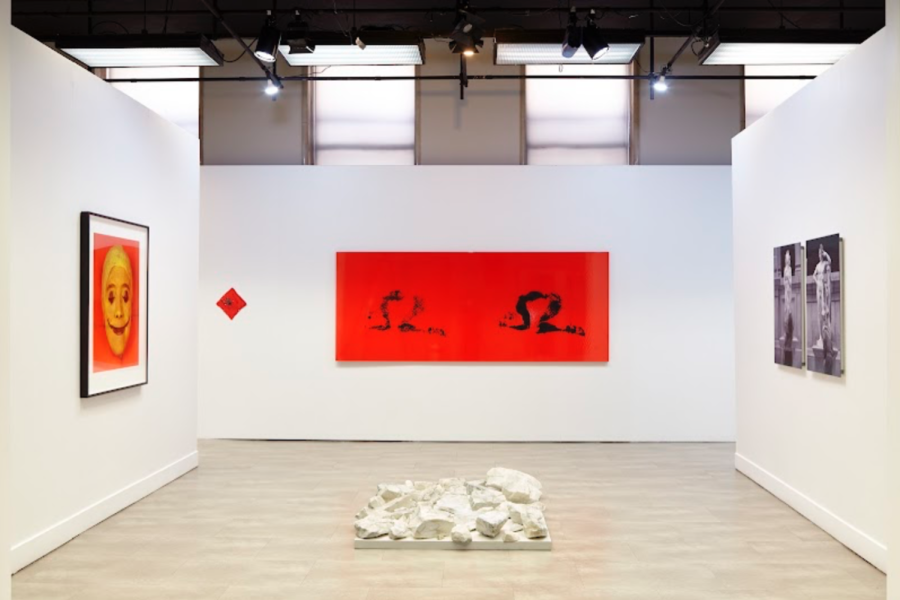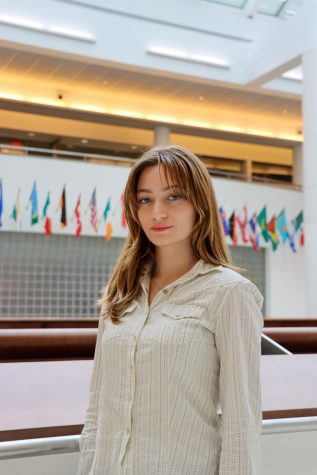Mishkin Gallery presents new exhibit: ‘What is Psychedelic’
March 20, 2023
The Mishkin Gallery held the grand opening of “What Is Psychedelic” on March 10 featuring the first institutional survey of artist Aura Rosenberg.
The two-venue display, co-presented by the Mishkin Gallery and Pioneer Works, follows Rosenberg’s artistic evolution from her early 1970s paintings to her more recent ventures in film, sculpture, photography and installation.
Much like a psychedelic drug, Rosenberg’s artwork lures the spectator into an altered mental state—like a psychedelic drug would—triggering an expansion of consciousness that lasts for the duration of their visit and beyond.
She accomplishes this not only through vibrant colors and fantastic imagery, but also through an incessant questioning of accepted notions on childhood, gender and sexuality.
The exhibition also highlights several unseen works, along with Rosenberg’s collaborations with artists Haim Steinbach, Louise Lawler, Mike Kelley, Mary Heilmann and Ei Arakawa.
Rosenberg created “What is Psychedelic”, the earliest work in this exhibition, when she was a student in the MA program at Hunter College in 1973.
In the five decades since then, Rosenberg’s career has taken her from New York to Berlin and back. Her work is imbued with cultural influences from both cities and themes such as gender, family and history.
“She examines how vernacular images naturalize and normalize meanings through which people understand themselves in the world.” the Mishkin Gallery wrote in a statement.
Rosenberg inverts the quotidian life in “Berlin Childhood”, by restaging German- Jewish philosopher Walter Benjamin’s autobiographical texts as a photographic series, a set of sculptures and more recently as films.
One installation, titled “The Sewing Basket”, is a tapestry of two young, medieval-era children playing in a field.. Below the tapestry is an unspooled ball of yarn, invoking a sense of nostalgia one might experience after finding an unfinished art project from their youth.
In “The Window”, Rosenberg superimposes Roy Lichtenstein’s black line “Curtains” onto an image of a window from her studio.
This work originates from an earlier series where Rosenberg layered “master” artworks over images, as if to spark a nonverbal dialogue between her own creations and that of earlier artists.
“Who am I? Where am I? What am I?”, depicts a human face painted with clown-esque makeup emerging from a red liquid, lending a whimsical twist to Rosenberg’s answer to age-old existential questions.
Rosenberg reconciles with the confines of masculinity with the aptly titled “Head Shots” , a series of close-up portraits of men in a state of sexual ecstasy.
Other series on view also played with the theme of eroticism. A graphic tile from “The Astrological Ways”, produced in collaboration with Mary Heilmann, depicts two entangled silhouettes against a red backdrop.
Rosenberg made “Calligraphs” by painting her body and pressing herself onto red vinyl to create the outline of an ambiguous pose. The resulting, horseshoe-shaped marks present as both a copy and an original; being an abstract and a recreation.
In “Couples Kissing”, Rosenberg captured intimate moments between her friends and neighbors.
“There’s a lot of pieces in this exhibition where red is noticeable and I like to connect love with red. It gives me that feeling.” said sophomore Carlos Nazario.
Some of Rosenberg’s more recent works include the series “Statues Also Fall in Love”. Visitors can gaze down at a collage on marble that features mythological figures etched onto stones, almost as if in a challenge to their presumed greatness.
“Aux Enfants de la Chance”, one of Rosenberg’s newest works, is perhaps the collection’s namesake. Painted in 2022, it defies the boundaries of modernist formalism through its uninhibited exploration of color and space.
“The artwork is kind of like a drug,” senior Ei Sin said, referring to the painting’s surrealist color palette.“You get high from it. I think that’s kind of the purpose.”
In the past, Rosenberg has held solo exhibitions at the Bauhaus Museum in Berlin and the Martos Gallery in New York.
The exhibition at the Mishkin Gallery was curated by Alaina Claire Feldmana and supported by the Weissman School of Arts and Sciences at Baruch College and Friends of the Mishkin Gallery.
It will remain open from March 10 to June 9.








